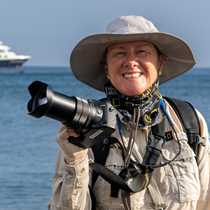Espanola Island
When days are filled from sunrise to sunset, time flies by and already we have arrived at the last island of the trip – too soon, way too soon.
In the freshness of early morning, intrepid kayakers left the ship to cruise the shoreline of Gardner Islet. This was the same location later in the morning for the snorkelers, and plenty was seen – even a small shark, possibly a Galápagos shark (not endemic) a little off-shore.
The main attraction as the sun rose was the visit to the one-of-a-kind beach at Gardner Bay, the northern coastline of Española Island. I say one-of-a-kind because although Galápagos may have long beaches of brilliant white sand, and beaches with groups of sea lions snoozing, but the combination is only here. I practiced my abstract photographic skills on sleeping sea lions because they are irresistible to me, to watch, to photograph, to listen to, and to share time and space with.
The afternoon took us to the western point of the island known as Punta Espinoza. It sticks out into the ocean like a landing strip, and is used as such by many sea birds: red-billed tropicbirds, Nazca boobies, blue-footed boobies, swallow-tailed gulls, Galápagos shearwaters, all our old friends from this past week, as well as one new one for today: the waved albatross.
The marine iguanas were the stars of the terrestrial world, being red and black on a daily basis on this isolated island. Come breeding season, green is added to the mix of color. The large males flaunted their colors in hopes of impressing and subduing the females long enough (five minutes?) to assure their genes will be passed along into the next generation. Espanola mockingbirds investigated everything, and the Galápagos hawks were overhead – on the beacon light as well as on the wing.
The big news of the afternoon was the presence of “Albie,” the last albatross on Punta Suarez, and seemingly the last chick (everyone else has migrated south with the trade winds) still there. An adult was seen flying overhead, but how much longer the parent (if that is what it was) can afford to stick around in an area that has practically non-existent winds, is anyone’s guess. We can only hope for the best. Now, for whom the “best” is, will only be told in time.
When days are filled from sunrise to sunset, time flies by and already we have arrived at the last island of the trip – too soon, way too soon.
In the freshness of early morning, intrepid kayakers left the ship to cruise the shoreline of Gardner Islet. This was the same location later in the morning for the snorkelers, and plenty was seen – even a small shark, possibly a Galápagos shark (not endemic) a little off-shore.
The main attraction as the sun rose was the visit to the one-of-a-kind beach at Gardner Bay, the northern coastline of Española Island. I say one-of-a-kind because although Galápagos may have long beaches of brilliant white sand, and beaches with groups of sea lions snoozing, but the combination is only here. I practiced my abstract photographic skills on sleeping sea lions because they are irresistible to me, to watch, to photograph, to listen to, and to share time and space with.
The afternoon took us to the western point of the island known as Punta Espinoza. It sticks out into the ocean like a landing strip, and is used as such by many sea birds: red-billed tropicbirds, Nazca boobies, blue-footed boobies, swallow-tailed gulls, Galápagos shearwaters, all our old friends from this past week, as well as one new one for today: the waved albatross.
The marine iguanas were the stars of the terrestrial world, being red and black on a daily basis on this isolated island. Come breeding season, green is added to the mix of color. The large males flaunted their colors in hopes of impressing and subduing the females long enough (five minutes?) to assure their genes will be passed along into the next generation. Espanola mockingbirds investigated everything, and the Galápagos hawks were overhead – on the beacon light as well as on the wing.
The big news of the afternoon was the presence of “Albie,” the last albatross on Punta Suarez, and seemingly the last chick (everyone else has migrated south with the trade winds) still there. An adult was seen flying overhead, but how much longer the parent (if that is what it was) can afford to stick around in an area that has practically non-existent winds, is anyone’s guess. We can only hope for the best. Now, for whom the “best” is, will only be told in time.




